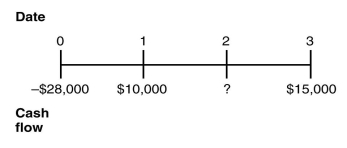A) $2695
B) $4312
C) $5390
D) $3234
Correct Answer

verified
Correct Answer
verified
Multiple Choice
You are offered an investment opportunity that costs you $28,000, has a net present value (NPV) of $2278, lasts for three years, has interest rate of 10%, and produces the following cash flows:  The missing cash flow from year 2 is closest to ________.
The missing cash flow from year 2 is closest to ________.
A) $12,500
B) $12,000
C) $13,000
D) $10,000
Correct Answer

verified
Correct Answer
verified
Multiple Choice
A rich donor gives a hospital $1,040,000 one year from today. Each year after that, the hospital will receive a payment 6% larger than the previous payment, with the last payment occurring in ten years' time. What is the present value (PV) of this donation, given that the interest rate is 11%?
A) $3,840,628.87
B) $5,376,880.42
C) $6,913,131.97
D) $7,681,257.74
Correct Answer

verified
Correct Answer
verified
Multiple Choice
Matthew wants to take out a loan to buy a car. He calculates that he can make repayments of $5000 per year. If he can get a four-year loan with an interest rate of 7.9%, what is the maximum price he can pay for the car?
A) $16,598
B) $19,918
C) $23,237
D) $26,557
Correct Answer

verified
Correct Answer
verified
Multiple Choice
What is the present value (PV) of an investment that will pay $500 in one year's time, and $500 every year after that, when the interest rate is 10%?
A) $2500
B) $4000
C) $3000
D) $5000
Correct Answer

verified
Correct Answer
verified
Multiple Choice
You are given two choices of investments, Investment A and Investment B. Both investments have the same future cash flows. Investment A has a discount rate of 4%, and Investment B has a discount rate of 5%. Which of the following is true?
A) The present value of cash flows in Investment A is higher than the present value of cash flows in Investment B.
B) The present value of cash flows in Investment A is lower than the present value of cash flows in Investment B.
C) The present value of cash flows in Investment A is equal to the present value of cash flows in Investment B.
D) No comparison can be made-we need to know the cash flows to calculate the present value.
Correct Answer

verified
Correct Answer
verified
Multiple Choice
Which of the following investments has a higher present value, assuming the same (strictly positive) interest rate applies to both investments? 
A) Investment X has a higher present value.
B) Investment Y has a higher present value.
C) Investment X and Investment Y have the same present value, since the total of the cash flows is the same for both.
D) No comparison can be made-we need to know the interest rate to calculate the present value.
Correct Answer

verified
Correct Answer
verified
Showing 61 - 67 of 67
Related Exams